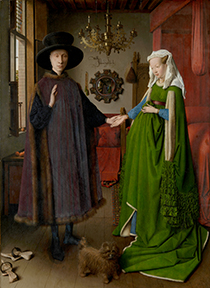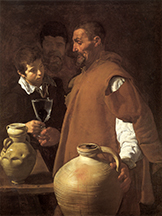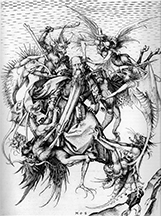|
READING
Illusion of Texture
Perhaps the greatest challenge for an artist wishing to create a convincing reproduction of visual reality is the texture of objects. The perception of texture is closely linked to the sense of touch. The artist has to somehow make something look like how it would feel. Jan van Eyck, painting in the Netherlands in the 15th century, paid minute attention to recreating as accurately as possible the textural details of the everyday world.

Jan Van Eyck, Arnolfini Double Portrait, 1434
In his double portrait of Giovanni Arnolfini and his wife, he manages to convey the "feel" of the fur bordering Giovanni Arnolfini's tunic which he carefully distinguishes from the shorter and denser white fur lining his wife's robe. He also distinguishes the texture of these furs from the long somewhat wiry hair of the dog. The smooth but wood-grained texture of the wooden floorboards is distinguished from the dense woollen pile of the rug.
 
Diego Velázquez, The Waterseller of Seville, 1623
In his painting of the Waterseller of Seville,the Spanish artist Diego Velázquez conveys both the surface texture and the cool, damp feel of the large earthenware vessel in the foreground.
The measure of an artist's success in conveying texture is the extent to which you believe that in touching what you see, you would actually feel the perceived texture.

Maurice Quentin de La Tour, Self-portrait, 1751
Many artists excelled in simulating the texture of fabrics. In his self-portrait done in pastels, the French artist Maurice Quentin de La Tour leaves you absolutely convinced of the softness of his blue velvet jacket.

Martin Schongauer, Temptation of Saint Anthony, c. 1480-90
Although the illusion of texture is best conveyed through colour, it can also be suggested through line alone. In his engraving of the Temptation of Saint Anthony, Martin Schongauer managed to render a whole range of textures — furry, leathery, hairy, spiky, scaly, slimy, rough, smooth — through the manipulation of the lines and marks his burin made on the copper plate.
|